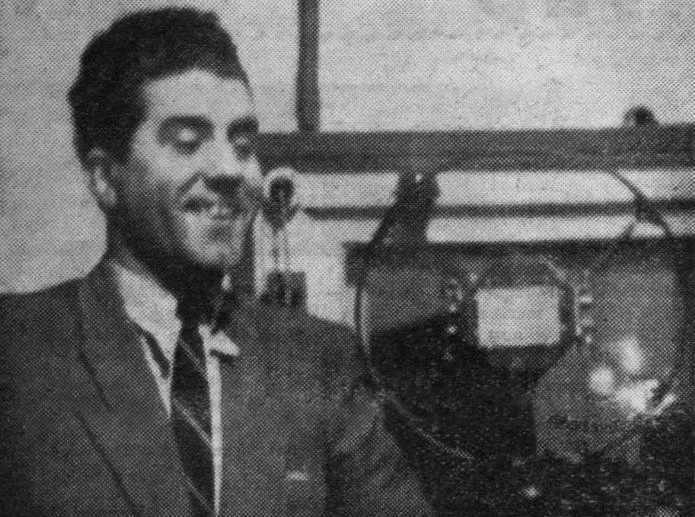
REŠAD BEŠLAGIĆ
A POPULAR SEVDALINKA SINGER BETWEEN THE TWO WARS
Author: Mirsad Ovčina, Media Center of the Islamic Community in Bosnia and Herzegovina • Illustration: Rešad Bešlagić

Rešad Bešlagić, a legendary singer of sevdalinkas between the two wars, was born in Tuzla in 1912, into an old family of agas. Until the agrarian reform in the Kingdom of Serbs, Croats and Slovenes, Rešad's father Nuraga owned a huge estate, a forest and land, which was misappropriated and decreased pursuant to the reform. He expressed love for singing very early, while he minded cattle as a child. When he found a shargia (long-necked lute) among his father's tings, he became interested in playing as well, and in a short time he learned how to played this instrument. Having shown his singing and playing artistry, he became popular in Tuzla and its surroundings. He graduated high school in 1928. Like his three brothers, Bešlagić studied law.
He began his professional singing career in Belgrade, in the early 1930s. As a student of the Faculty of Law in Belgrade, he sang at Belgrade Skadarlija, a meeting point of sevdalinka lovers and a place famous for good songs, singers and enjoyment. The word soon got out that he was an experienced singer of folk songs. Thus, he soon reached Radio Belgrade, where he would become a professional singer for Radio Belgrade. In folk music programs of the time he sang sevdalinkas live, accompanied by tambura and folk music orchestra of Vlastimir Pavlović Carevac (1895–1965), a famous violinist and lawyer. Carevac had high standards for folk music performers, and only the greatest singers could stand before his orchestra. Rešad was at the very top and one of the most popular singers of sevdalinka in Yugoslavia. Thanks to him and some other our singers, ambassadors of Bosnian and Herzegovinian song, such as Sulejman Džakić (1904–1978) from Bosanski Šamac, Vuka Šekerović (1903–1976) from Zenica and others, sevdalinka became extremely popular throughout Yugoslavia. Belgrade gentlemen particularly loved to listen to our songs and enjoy in them, and singers from Serbia gladly learned the songs from their Bosnian colleagues and sang them in their own appearances later on. Sevdalinka “Pod Tuzlom se zeleni meraja” was one of Rešad's favorite songs and one of his most brilliant performances.
Although he had all the necessary potentials and fantastic vocal abilities to become an opera singer, he never showed an interest in classical music since he believed that this kind of music cannot offer him much. Indeed, he believed that voice training can destroy the feeling for the folk song and deprive it of the “soul”. At the time, there were attempts to educate folk singers in music and that they could sing folk songs at sight. Understandably, such views were unacceptable for most singers since it would restrict the breadth and the beauty of performing the folk song.
Occasions when Rešad sang “over the radio” were a true feast for sevdalinka lovers. Rešad was not loved only for his song and voice; he was also a favorite character because of his gentlemanly manners and physical beauty. He was very sociable and was invited to many parts of the country.
Upon completing his studies, he got a job with the Ministry of Railways. He was also a member of the Muslim cultural society “Gajret”. Immediately after the outbreak of the Second World War in 141, he joined the People's Liberation Movement in Sarajevo, like many members of “Gajret”. Shortly before the end of the war he was arrested together with another three Tuzla residents. They were all killed on 4 April 1945 as members of Sarajevo underground movement. It happened immediately before liberation of Sarajevo, in ustasha concentration camp – villa “Wilkert” at Skenderiji, which was used by the notorious ustasha commander Vjekoslav Maks Luburić. In his book Genocid nad Bošnjacima u Drugom svjetskom ratu (Genocide over Bosniaks in the Second World War), Smail Čekić noted the data that the „court-martial of the headquarters of colonel Luburić in Sarajevo for crimes against the survival of the Independent State of Croatia“ reduced Bešlagić's capital punishment by shooting to the sentence of restricted imprisonment: “Pursuant to the verdict of 14 April, UKP 7/1945, Bešlagić Rešad, son of Nuraga, born in Tuzla in 1909, a clerk in the Ministry of Croatian State Railways in Sarajevo, is sentenced to two years of restricted imprisonment ” (Čekić: 1996). Six days after the killing of Rešad Bešlagić, on 10 April, the autopsy was performed, after which 22 more victims of ustasha terror were found.
The popularity of Rešad Bešlagić is confirmed by the data published in the newspaper Islamski glas on 03.01.1936 (no. 14) on the Eid ul-Fitr party in Tuzla. In the article entitled “Uspjeh zabave 'Narodne uzdanice' u Tuzli” (The success of the party by 'Narodna uzdanica' in Tuzla), which took place on 28.12.1935, we read the following: “With respect to sevdalinkas, Rešad Bešlagić sang several of them, and impressed the audience with his performance and intonation of his voice, and was therefore often interrupted by their applause... Our thanks also go to Rešad Bešlagić, who spared no effort ... to make the party as good as possible.”
Rešad Bešlagić left a significant trace on later performers of sevdalinka, mostly on Zaim Imamović, who singled him out as an unparalleled singer and his role model. As a professional radio singer, Bešlagić was active until the outbreak of the war in Yugoslavia. Since the equipment for recording archival materials was acquired as late as in 1954, the archives of Radio Belgrade, unfortunately, have not preserved a single sound recording of this famous performer of sevdalinka.


